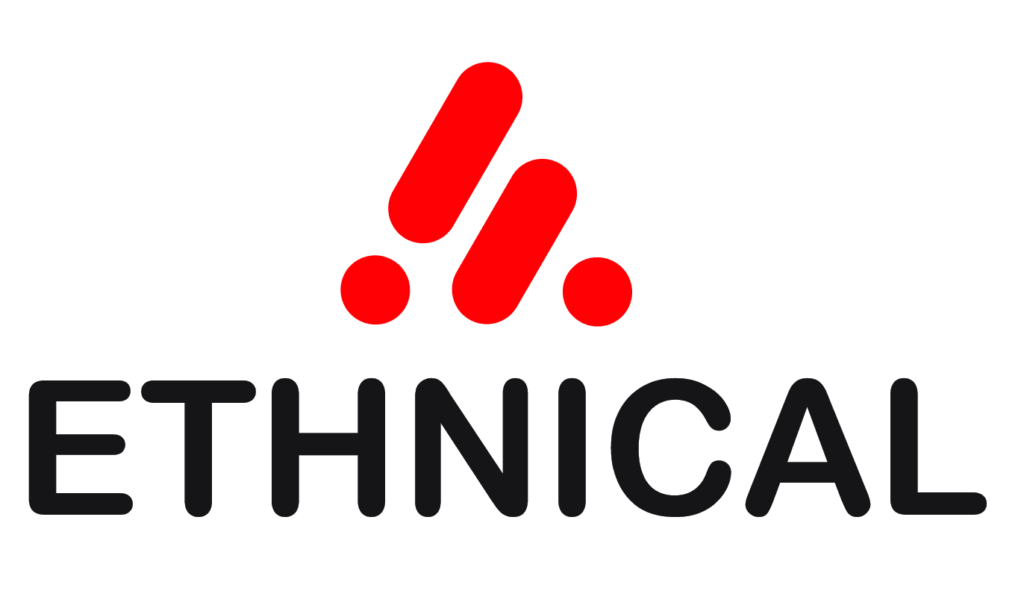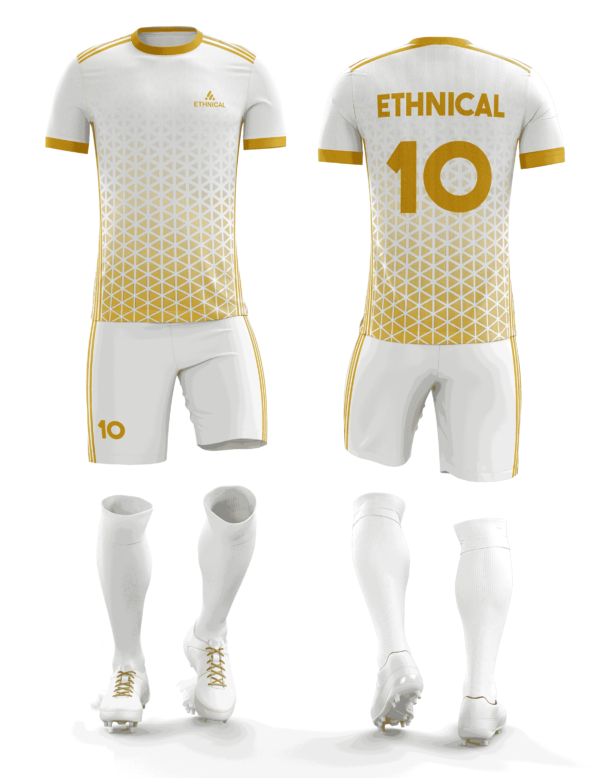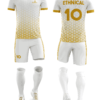Description
Soccer Uniform
Soccer Uniform is known in many parts of the world, is a sport that captures the hearts of millions. Beyond the thrill of the game itself, the uniforms worn by soccer players play a crucial role in the sport’s identity and aesthetics. In this detailed description, we will explore the intricate elements that make up a soccer uniform, from the jersey to the socks, delving into the design, materials, and cultural significance.
The centerpiece of any soccer uniform is undoubtedly the jersey. Crafted with precision and innovation, the jersey is more than just a piece of clothing; it is a symbol of a team’s identity. Typically made from lightweight, breathable materials, such as polyester, the soccer jersey ensures that players remain comfortable and agile on the field. The fabric wicks away moisture, allowing players to stay dry even during intense moments of the game. The stretchability of the material is another crucial factor, providing players with the freedom to move unrestricted as they dribble, pass, and shoot.
Designing a soccer jersey is an art form that involves a combination of colors, patterns, and sponsor logos. Teams often choose colors that represent their identity, whether it’s the national colors for international teams or the signature hues of club teams. The design of the jersey often includes unique patterns, stripes, or geometric shapes that add flair and distinguish one team from another. These elements are not merely decorative; they serve to enhance the visibility of players on the field, helping teammates and fans identify them from a distance.
The front of the jersey typically features the team’s crest or logo, a symbol that embodies the spirit and history of the club or national team. This emblem is a source of pride for players and fans alike, representing the collective identity and aspirations of the team. The placement of the crest is strategic, often over the heart, symbolizing the passion and commitment that players bring to the game. Additionally, sponsor logos are commonly displayed on the front of the jersey, providing financial support to the team while also creating a canvas for brands to reach a global audience.
Moving to the back of the jersey, the player’s name and number are prominently displayed. The numbering system is not arbitrary; each position on the field corresponds to a specific range of numbers. For example, goalkeepers usually wear numbers 1, 13, or 25, while outfield players may wear numbers within the range of 2 to 23. The player’s name adds a personal touch to the uniform, fostering a connection between the athlete and the fans. This tradition also facilitates communication on the field, as teammates can easily identify and address each other during the game.
Sleeves and collar design contribute to the overall aesthetics of the jersey. Some jerseys feature short sleeves, providing a classic look that harks back to the sport’s roots. Others opt for long sleeves, offering additional coverage and protection during colder weather. The collar may be crewneck, V-neck, or have a buttoned design, each contributing to the overall style and functionality of the uniform. These design choices are often influenced by tradition, fashion trends, and the preferences of players and fans.
Moving down from the jersey, soccer shorts are a crucial component of the uniform. Similar to the jersey, shorts are crafted from lightweight, breathable materials that facilitate ease of movement. The length of the shorts has evolved over the years, with some players favoring shorter styles for increased agility, while others prefer longer cuts for additional coverage. The waistband of the shorts is typically elastic to provide a secure fit, and a drawstring may be included for further adjustment.
Socks, often overlooked but essential, complete the lower half of the uniform. Soccer socks are designed to provide support and comfort, with elastic cuffs ensuring that they stay in place during the game. The socks are typically made from a blend of materials, including nylon, spandex, and cotton, to offer a balance of durability, stretch, and breathability. Additionally, soccer socks often feature cushioning in key areas, such as the heel and ball of the foot, to enhance comfort and reduce the impact of constant running and sudden stops.
Footwear is a critical aspect of a soccer player’s attire, though it is not technically part of the uniform. Soccer cleats are designed to provide traction on the grass or turf, allowing players to make sharp turns, accelerations, and decelerations with precision. Cleats come in various designs, with different stud patterns optimized for specific playing conditions. The choice of cleats is highly personal, with players selecting models that suit their playing style, position, and preferences.
Beyond the technical aspects, soccer uniforms hold immense cultural significance. The colors, symbols, and designs of a team’s uniform often reflect the history, values, and identity of the community it represents. National team jerseys, in particular, evoke a sense of patriotism and pride, with fans proudly donning the colors of their country during major tournaments. Club team jerseys, on the other hand, become a symbol of local identity and the shared passion of supporters.
In conclusion, a soccer uniform is far more than a practical ensemble for a sports match. It is a meticulously designed and culturally rich representation of a team’s identity. From the jersey that proudly displays the team’s crest to the socks that offer comfort and support, every element of the uniform contributes to the holistic experience of the game. As players step onto the field, they don more than just a uniform; they wear the embodiment of a team’s history, aspirations, and the collective spirit of fans around the world.



Reviews
There are no reviews yet.